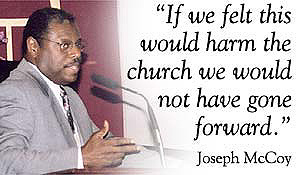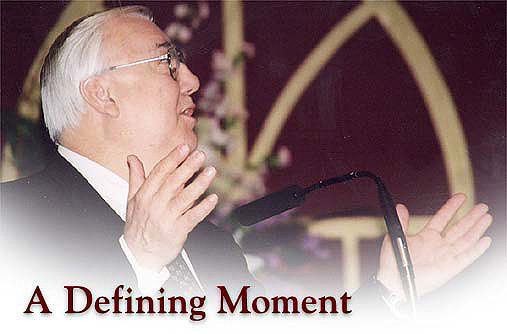 very now and then a major council of the Seventh-day Adventist
Church confronts the participants with a moment of truth. The procedure followed
very now and then a major council of the Seventh-day Adventist
Church confronts the participants with a moment of truth. The procedure followed
 and the actions taken often shape the future for good or for ill.
and the actions taken often shape the future for good or for ill.
Leaders from North America came to such a fork in the road at the
recently concluded Year End Meeting. Two emotionally charged items coalesced
in a potent brew�retirement and race. The potential for anger, words that would
leave long-lasting scars, and even separation was high.
In the church as in society, the security of retirement benefits
carries heavy weight. For many years the North American Adventist church has
followed a defined benefits plan: retired ministers, teachers, and other workers
receive monthly benefits according to their years of service, with maximum benefits
being calculated on 40 years.� By design this plan was never fully funded: contributions
flowed in, mainly from conferences, and disbursements flowed out. To fully fund
the plan would require many hundreds of millions of dollars and the division
has all along considered that funds should not be tied up in this manner. Instead,
it keeps funding at about a three-year level�that is, about three times the
funding for a single year.
This longstanding plan was �frozen� as of December 31, 1999. In
its place a defined contributions scheme was introduced: the employer makes
basic tax deferred contributions for each eligible employee, with an additional
matching amount for those employees who choose to make voluntary contributions
of their own through payroll deduction. It is now up to the worker to manage
the account individually.
Under the new plan the division does not have to set aside funds
in a long-term account. The old, defined benefits plan has to be maintained,
however, to keep checks flowing to the 14,500 or so retired people who currently
receive benefits and those many more who will retire under this plan in the
future. Thus, since January 1, 2000, conferences in North America have continued
to make payments into the old plan (these will decrease over time) as well as
provide basic and matching contributions for employees under the new plan.
This sets the stage for the defining moment.
 Eight conferences do not like the new plan because it puts the
onus for retirement on the worker rather than the employer; they have developed
a separate, defined benefits plan. Further, they have prepared careful studies
that show that these conferences have contributed far more to the funding of
the old plan than the benefits received by retired workers from those conferences.
These eight conferences therefore state that they will not contribute the full
nine percent of tithe expected of conferences to keep the old plan viable.
Eight conferences do not like the new plan because it puts the
onus for retirement on the worker rather than the employer; they have developed
a separate, defined benefits plan. Further, they have prepared careful studies
that show that these conferences have contributed far more to the funding of
the old plan than the benefits received by retired workers from those conferences.
These eight conferences therefore state that they will not contribute the full
nine percent of tithe expected of conferences to keep the old plan viable.
The eight conferences are all regional (African�American). The
remaining regional conference has not so far joined with the eight.
A potent mix indeed. On one side, long standing feelings of inequities
coupled with anxiety over adequate retirement. On the other, dismay and anxiety
over keeping the old plan secure. A volatile situation ripe for accusations
and counter�accusations, for circling the wagons and separating into camps of
�us� and �them�. The immediate casualties would be mobility of workers from
one conference to another, and so on; the larger fall�out would be the unraveling
of the North American Division as a smooth, functioning body of conferences
operating under the same terms.
Going into the Year End Meeting division president Don Schneider
and other leaders had grave concerns about the impact of this item. Schneider
sought counsel from all sides, especially from revered figures in the Black
community like Elder Charles E. Bradford. Prayer and fasting became the backdrop
of this year�s meeting.
And Schneider and his associates changed the format for discussion
of this explosive issue. Instead of the usual procedure where leaders introduce
actions to be discussed, amended, and voted up or down, they called for a town�hall
forum. Presentations were made, reactions from the body entertained, and questions�oral
or written�asked. But no motion could be introduced: the purpose was informational,
so that the various aspects and feelings could emerge in a free, open setting.
Schneider, chairing the meeting, declared that he did not have
the answer, but that together the delegates would try to find the answer. He
made clear that the meeting would provide the basis for subsequent meetings
with the conferences involved until a solution was found. Referring frequently
to counsel from Ellen White in Testimonies, vol. 8, pp. 10�12, he drew
particular attention to her admonition: �My brethren, allow nothing to come
in that will separate you from one another or from God� (p. 12).
A wonderful spirit prevailed throughout. The meeting worked just
as the leaders had hoped�probably better than they had hoped. Information was
shared, possibilities raised, concerns aired, hurts and suspicions laid bare.
And key leaders across the racial lines publicly expressed their determination
that this issue must not be allowed to destroy or damage the unity of the church.
One year ago the NAD convened a summit on race. It was an important
beginning, but only a beginning. Words and speeches have to be translated into
systemic change. We Adventists are a people on the move, journeying toward the
light on the hill where people of all races and backgrounds are treated with
respect and dignity, and feel that they are. The defining moment of� this year�s
council was an important milestone along that journey.���������������������
_________________________
William G. Johnsson is the Editor of the Adventist Review.


